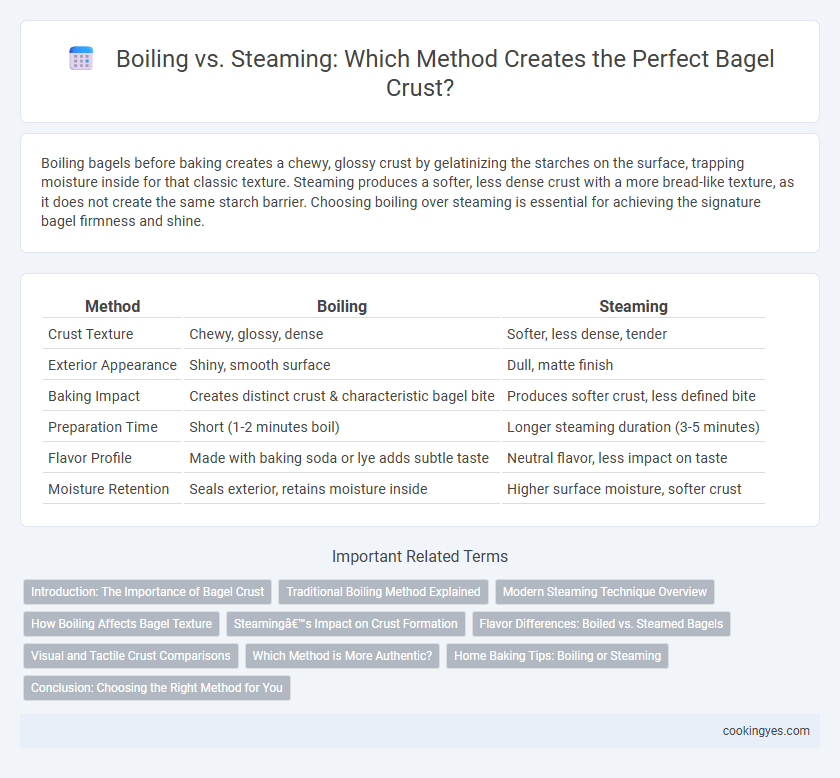Boiling bagels before baking creates a chewy, glossy crust by gelatinizing the starches on the surface, trapping moisture inside for that classic texture. Steaming produces a softer, less dense crust with a more bread-like texture, as it does not create the same starch barrier. Choosing boiling over steaming is essential for achieving the signature bagel firmness and shine.
Table of Comparison
| Method | Boiling | Steaming |
|---|---|---|
| Crust Texture | Chewy, glossy, dense | Softer, less dense, tender |
| Exterior Appearance | Shiny, smooth surface | Dull, matte finish |
| Baking Impact | Creates distinct crust & characteristic bagel bite | Produces softer crust, less defined bite |
| Preparation Time | Short (1-2 minutes boil) | Longer steaming duration (3-5 minutes) |
| Flavor Profile | Made with baking soda or lye adds subtle taste | Neutral flavor, less impact on taste |
| Moisture Retention | Seals exterior, retains moisture inside | Higher surface moisture, softer crust |
Introduction: The Importance of Bagel Crust
Bagel crust plays a critical role in defining the texture and flavor, with boiling and steaming being the primary methods to achieve the ideal crust. Boiling bagels in water with malt or baking soda creates a distinctive chewy exterior and shiny finish, enhancing flavor development through caramelization. Steaming, by contrast, produces a softer crust with less browning, impacting the traditional density and bite associated with authentic bagels.
Traditional Boiling Method Explained
The traditional boiling method for bagel crust involves submerging the dough in boiling water briefly before baking, which creates a dense, chewy exterior with a glossy finish. This process gelatinizes the starches on the surface, preventing excessive oven spring and ensuring the crust forms properly. Steaming, by contrast, produces a softer crust without the same characteristic chewiness and shine typical of authentic bagels.
Modern Steaming Technique Overview
Modern steaming techniques for bagels create a soft, shiny crust by exposing the dough to high humidity and moderate heat, preserving moisture and enhancing chewiness without the dense texture produced by boiling. Steaming locks in the bagel's internal moisture while allowing for a thinner, more delicate crust, making it a preferred method for achieving a tender bite and subtle gloss. Innovations in steam ovens and controlled steam injection systems enable bakers to precisely manage temperature and humidity, optimizing crust quality and overall bagel texture.
How Boiling Affects Bagel Texture
Boiling bagels before baking gelatinizes the starch on the surface, creating a dense and chewy crust characteristic of traditional bagels. This process also helps the crust to develop a shiny, crisp finish by sealing in moisture within the dough. In contrast, steaming produces a softer crust, lacking the signature chewiness and crusty texture that boiling imparts.
Steaming’s Impact on Crust Formation
Steaming bagels creates a softer, more tender crust by introducing moisture that prevents the outer dough from drying out too quickly during baking. This method results in a shinier surface and a less chewy texture compared to boiling, which typically produces a denser, crispier crust due to the starch gelatinization from water immersion. The steam environment promotes even heat distribution, enhancing crust elasticity and improving the overall mouthfeel of the bagel.
Flavor Differences: Boiled vs. Steamed Bagels
Boiling bagels creates a chewy crust with a slightly tangy flavor due to the Maillard reaction triggered by the alkaline water, while steaming produces a softer, less crispy exterior lacking that distinctive chew. The boiling process also thickens the crust and intensifies the caramelization, enhancing the traditional bagel flavor. Steamed bagels tend to be lighter and fluffier but miss the robust taste and texture that define classic bagels.
Visual and Tactile Crust Comparisons
Boiling bagels creates a shiny, dense crust characterized by a slightly blistered, chewy texture that is visually glossy and tactilely firm. Steaming produces a softer, matte crust with a lighter, pillowy feel, lacking the distinct chewiness and crackle of a boiled crust. The contrast in method significantly impacts both the appearance and tactile experience, where boiling yields a traditional, resilient crust and steaming results in a tender, less compact exterior.
Which Method is More Authentic?
Boiling is the more authentic method for achieving the traditional bagel crust, as it gelatinizes the starch on the dough's surface, creating a chewy texture and glossy finish that defines classic bagels. Steaming, while producing a softer crust, lacks the characteristic crunch and density associated with true New York-style bagels. This water boiling step distinguishes authentic bagels from other bread, ensuring the signature crust that bagel enthusiasts seek.
Home Baking Tips: Boiling or Steaming
Boiling bagels before baking creates a dense, chewy crust with a glossy finish, thanks to the gelatinization of starch on the surface. Steaming, though less traditional, yields a softer crust with a lighter texture by trapping moisture during baking. Home bakers aiming for authentic, crisp crusts should prioritize boiling, while steaming suits those preferring a tender bite.
Conclusion: Choosing the Right Method for You
Boiling bagels creates a dense, chewy crust with a shiny finish, ideal for a traditional New York-style texture. Steaming produces a softer crust with a more bread-like consistency, preferred by those seeking a lighter bite. Your choice depends on whether you prioritize a classic crispiness or a tender crust in your bagel experience.
Boiling vs steaming for bagel crust Infographic

 cookingyes.com
cookingyes.com